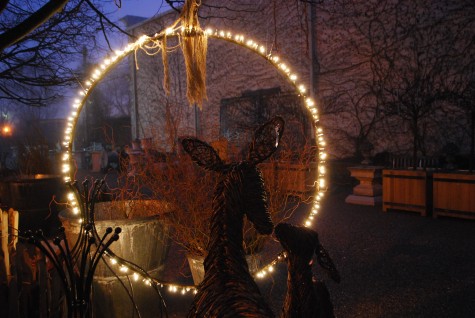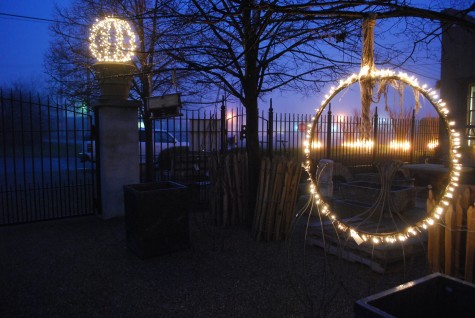Yesterday’s dawn was wet and foggy. Beautiful weather like this is rare here in late December. That fog was making the visual most of Rob’s light rings. Formally drawn and constructed geometric shapes are so compelling in the landscape. A circle has no beginning or end; it is complete. It is a very stable shape; it completely encloses a space, or a view. A working circle is a wheel, whose invention revolutionized how people live. This lighted circle is working in a different way.
It illuminates a space, and frames a view. It is a topiary form of light. The light is focused-a far cry from the diffuse light that comes from the sky. We see very little in the way of sunlight this time of year. A lighted garden is never so welcome as it is in the winter. Expressions of topiary in the landscape has a long history. Fruit trees trained into a two-dimensional shape are called espaliers, after the French monk who invented this method of pruning. The Chicago Botanic Garden has an extensive display of espaliered trees, and landscape sculpture created from living plant material. Any plant grown and trained into a shape is a topiary. This would include bonsai, the boxwood at Dunbarton Oaks pruned into continuous cloud shapes, the topiary guard house at Fluery-en-Biere, the topiary pyramids at Mormaire, the spectacular thuja pergola at Chateau de Hautefort. A good part of their majesty is their age, and the faithful care they demand and recieve.
A rigid topiary form is useful for training plants into a geometric shape. Arborvitae planted in proximity to an iron arbor can be pruned into that arbor shape, given enough time. Young fruit trees trained over an iron arbor will eventually mature into that tunnel shape, and no longer require support. A row of trees pruned into triple cordons will eventually make a living fence that is free standing. Vines can be trained onto a topiary form as well; we have had beautiful triple ball ivy topiary sculptures on occasion. The rigid form is a guide that insures that the shape is pleasingly and regularly geometric.
Vines permitted to scramble over a topiary form is a different, but just as pleasing look. Old trees can provide a very sculptural support for an old Baltic ivy vine, or a climbing hydrangea. A rock pile, or a gate post can give form and support to a clematis. Willow or bamboo tripods are good for growing beans, tomatoes, or morning glories. Topiary forms whose primary job is to provide support for a lax growing plant are called plant climbers, or tuteurs.
For a number of years Monrovia sold juniper ring topiaries. They were surprisingly attractive, easy to keep trimmed, and they were amenable to being grown year round in pots. Should you have to have a juniper, this is a pretty way to own one. I have seen angel vine, myrtle, miniature ivy varieties, boxwood and pyracantha trained on a topiary ring. Once that ring form is rotated in space, you have a spherical form. The same aforementioned plants can be just as easily trained on these forms. Vining plants can be wound on the ribs of the sphere, or allowed to scramble over and cover the form.
A topiary form is the fastest way to grow a topiary. A 6′ diameter boxwood sphere takes a long time to grow into its finished shape. The boxwood spheres at the corners of the boxwood rectangle in front of the shop are 13 years old; they came to me 30″ by 30″. As they have no rigid form inside, they have to be hand pruned by eye into a sphere. I leave this job to Mindy; my handpruned spheres invariably have flat spots.
A topiary form may also be the fastest and most striking way to create a light sculpture. The only requirement-a sturdy form, and holiday light strings with brown cords. The light they cast this foggy morning convinced me a topiary form can mean as much to a winter landscape as it does to a summer one. The pot on your front porch with a topiary form that provided a home to a mandevillea over the summer can light the winter landscape all winter long.
Other people have had the same idea about Rob’s light rings. He tells me this morning we have sold 58 of them this season. They are so beautiful hanging from our trees on the driveway.

They do an incredible job of softly illuminating a wide area, and vividly illuminating an intimate place. I am just now thinking we need some in the front windows of the shop. I may be late getting to this idea, but the winter will be long.
If your topiary forms that spend the winter in the shed, you might want to rethink that. They could bring some light and warmth to your winter landscape.
On this the darkest day of our year, what would I do without this light?









